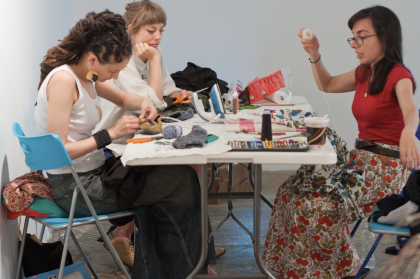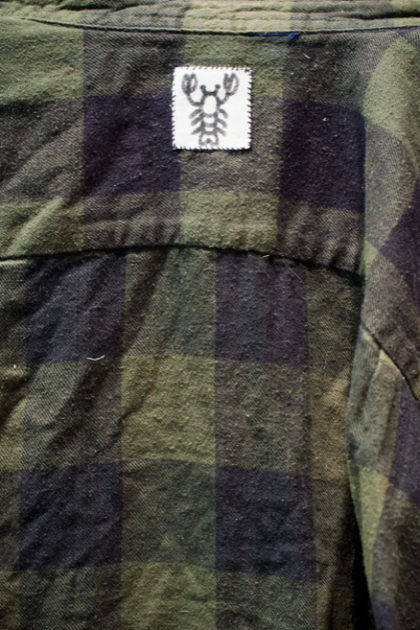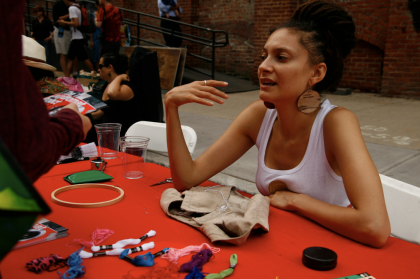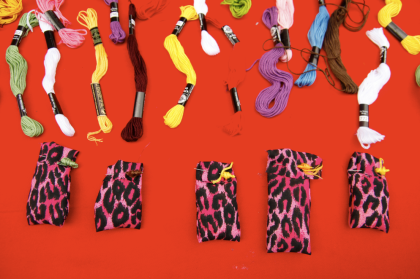Text and images below are reposted from Uppsala University Library’s website.
———————
The manuscript dates from the 14th century and it belonged to the monastic library at Vadstena Convent after its purchase in Konstanz in 1417.

The pages of the book are made of parchment and they show typical damage in the form of holes and tears that happened while the parchment was being made. Some time after the book was copied, the holes and tears have been mended artistically with silk of various colours, mainly in blanket stitch as used in embroidery.
The old mending is in good shape except for those parts which were sewn with black silk. The thread is so fragile that it disintegrates on touch.

During the project the black thread was subjected to colour analysis to find out which colouring agents had been used. The results showed that the black dye had been made with iron sulphate and tannin, which implies that the thread was dyed with iron filings and various plants that contain the tanning agent tannin e.g. oak apple and sumac leaves. The whole dyeing process is very acidic and if the wrong proportions of tannin and iron salt are used, sulphuric acid forms considerably accelerating the natural decomposition of the thread or material. In order to prevent the black parts disappearing completely they were treated with a glue that was applied as a spray mist. Some parts were stabilised with a thin silk gauze.

Since the conservation process the book can be handled without the breaking the black thread but it still has to be treated very gently with the respect due to a book of its age.

Hey Anne, do you still have your blog about repairs? I fixed my shoe.
Hey Allan! Thank you for the photo! I will post it. What happened to your shoe? I have kept Repaired Things going, but just barely.
It’s what happens will all my shoes, the inside of the back of the heel came undone. And all the shops were like, “Oh, we can’t fix that. You have to stop kicking your shoes off.” Scolding me! So there was this flap of shoe hanging around the inside, so I sewed that very crude patch on.
There are plenty of people in India who will fix things like that. Our cobblers are just lazy.
Besides, it is worth it in the long run. We are just externalizing the costs of producing cheap goods; the costs are there in environmental harm and human rights abuses; we just don’t see them. So if I want to not hurt anyone with the things I wear, it might be cheaper to pay $20 for my things to be repaired rather than buy expensive new free trade / organic shoes.
Workshop lead by Sewing Rebellion NYC at NURTUREart, May 27, 2012
Photos by Tsubasa Berg
Filed under: fabric, leather, rubber | Tags: broken, cut, mended, sewn, stitched, torn
I wore this pair of sandals the whole 7 months I was in India. Pretty soon, the soles started wearing thin. I could feel pebbles through the soles. So, when these kids approached me at a train station and offered to repair them for me, I asked them to make an insert.
The insert fell out pretty quickly since it wasn’t sewn in properly, so in Vrindavan, I had this cobbler sew in a proper insert for the heel. Perfecto.
Eventually, that wore down too, and a cobbler in Bangalore sewed an entire new sole to the bottoms of the existing ones. New treads!
No photo of the last repair, but I had another Bangalorean cobbler tighten the strap that goes between your toes. 3 years later and they’re still a major component of my summer gear!
A friend said they are probably one of the only pairs of cobbled Airwalks in the world.
Langmusi China, 2006. One handle had pulled off my tote bag, and this guy stitched it back on and reinforced the other one.
Very cool sewing machine! Looks like he’s mainly a cobbler.
Boro Cotton Kimono, Yamagata Prefecture (Northern Japan) c. 1900
“Boro textiles were made in the late 19th and early 20th century by impoverished Japanese people from reused and recycled indigo-dyed, cotton rags. What we see in these examples are typical—patched and sewn, piece-by-piece, and handed down from generation-to-generation, where the tradition continued. These textiles are generational storybooks, lovingly repaired and patched with what fabric was available. Never intended to be viewed as a thing of beauty, these textiles today take on qualities of collage, objects of history, and objects with life and soul.” — via Accidental Mysteries
This image (via Wafu Works) reminds me of Tsubasa’s Jeans, which his mother has mended over and over again.
Filed under: fabric, wood | Tags: glued, lost, replaced, sewn, taped, torn, worn
A year and a half late …. (yikes)
I set up a “Repair Booth” at Heather’s awesome Barter Town project …

Pocket hole

George actually broke his pencil and then handed it to me to repair. What?? I think I used glue and then prettied it up with yellow duct tape.

Redid part of Jackie’s seam.
At Barter Town, I met Maya of the NYC chapter of Sewing Rebellion. She was giving out these little mending kits and teaching folks to sew buttons and disguise stains with embroidery.
From their mission statement:
Sewing Rebellion meetings are a way for people to help each other reclaim basic sewing skills, mending skills, tailoring, and so on. SR meetings are FREE, because sewing should be a right, not a privilege. As a former coordinator (and current “traveling correspondent”) said, “people buy something at Kmart and it gets a hole in it and they go and buy another one. That’s problematic for a number of reasons. It’s supporting the worldwide garment industry, which is extremely exploitative, so that we can have cheap stuff that breaks. It’s also contributing to everyone looking the same. You spend a lot of money and you look like everybody else, and you’re helpless when things break or don’t work. This is just a simple way that you can be more self-sufficient.” Well said Amelia. Hence, the SR tagline “Stop Shopping, Start Sewing!”
Hell yeah!! Sewing=Rebellion. Repair=Revolution.
Also check out their simple PDF guides to simple repairs and a Mending Circle every first Thursday at the Textile Arts Center.


























